Blood Lust – Technologically Forwards Socially Backwards (it’s all about programming)
Medieval Torture, we haven’t come a long way.
Remember (for example) the next time you get on a plane and fly over airspace that is being used for war that whilst you’re off on a business or leisure trip there are people, animals and land being ripped apart in some of the most brutal ways right underneath you that you might never have heard of or forgotten even if it’s on the news everyday. Weapons of war get more ‘sophisticated’ from biochemical warfare to cluster bombs and ones that release masses of tiny blades to cut up everything in reach leaving survivors to take remains of loved ones and those around in carrier bags.
Many of the methods below don’t occur anymore but quite frankly if/when people could/can get away with such things, they do and can’t you just imagine those who would want to. This is why I aspire to pacifist yet we live in such a violent world.
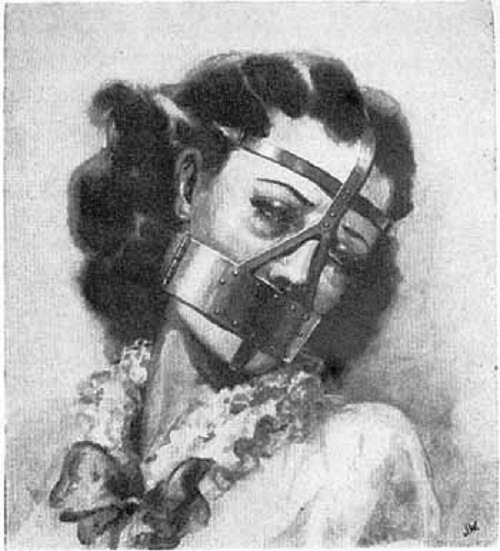
The Scold’s Bridle or Branks Bridle – I remember reading husbands used this to silence ‘nagging’ wives and it could even be heated up – it also has a plate that fits onto the tongue.
England, Wales and Scotland
First recorded in Scotland in 1567, the branks were also used in England, where it may not have been formally legalized as a punishment. The kirk-sessions and barony courts in Scotland inflicted the contraption mostly on female transgressors and women considered to be rude or nags or common scolds.[3][4]
Branking (in Scotland and the North of England)[5][6] was designed as a mirror punishment for shrews or scolds; women of the lower classes whose speech was deemed “riotous” or “troublesome”;[7] — often women suspected of witchcraft — by preventing such “gossips or scolds” from speaking. This also gives it its other name ‘The Gossip’s Bridle’
It was also used as corporal punishment for other offences, notably on female workhouse inmates. The person to be punished was placed in a public place for additional humiliation and sometimes beaten.[8] The Lanark Burgh Records record a typical example of the punishment being used, ” Iff evir the said Elizabeth salbe fund scolding or railling… scho salbe sett upone the trone in the brankis and be banishit the toun thaireftir” (1653 Lanark B. Rec. 151).
…
Germany
During the 1500s it spread to some other European countries, including Germany. Some bridles even had a bell on top of them to draw more attention to the wearer, thus increasing their humiliation. It continued in use until the early 1800s as a punishment in German workhouses.[9]
————————————————————————————————————————————–
The post below is from: Feminism and women’s rights
A call to feminists to remember the history and sex-based nature of women’s oppression
writing by renee
Trigger warning: feminism, women’s rights
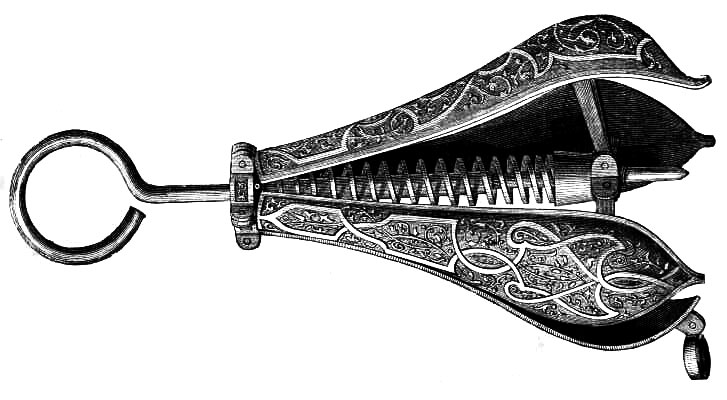
The real brilliance of patriarchy… it doesn’t just naturalise oppression. It sexualises acts of oppression. It eroticises domination and subordination. It institutionalises them as masculinity and femininity. So, it naturalises, it eroticises and it institutionalises domination and subordination. The brilliance of feminism is that we figured that out. – Lierre Keith
In recent months, so much legislation has been passed or proposed in the U.S. and elsewhere to indicate a frightening escalation in the war – yes, it is a war – on women. The Russian parliament just voted 380-3 to decriminalise domestic violence. This is in a country where an average of 40 women per day – 14,000 women per year – are murdered by male partners. The United States, where over 1,000 women are murdered by their partners per year, has of course just elected a president who boasts that “when you’re a star, they let you do it, grab them by the pussy”, and has been involved in pornography and sex trafficking. He plans to eliminate funding for 25 domestic violence programmes, and is ordering female staffers to “dress like a woman”. Texas is now looking to remove voting rights from women who have had abortions; Arkansas, to enable rapists to sue women for having them.
All of these advances rest, of course, on a long established notion of women as male property. The stigma on abortion rests on the idea that women do not create human life through a ten month process of gestation and labour; men ejaculate life into women, and women, as state-regulated incubators, are obligated to carry it to term. Domestic violence, the porn and prostitution industries that fuel sex trafficking, dress codes – these all rest on the same principle of male sexual entitlement. No wonder commentators are calling the current coming to life of Margaret Atwood’s Handmaid’s Tale; a new era of more orthodox, strictly designated rules and roles for women in the West. All justified through myths that women are biologically predisposed to such roles and rules.
Given the situation we face, it is alarming to confront the reality that the left is equally as ill-equipped and unwilling to discuss women’s oppression as the conservative right. Nowadays, notions of “gender identity” for instance, are threatening to swallow women’s collective understandings of sex-based oppression whole. A “gender identity” ideology claims that gender is a personal matter of identification, and one’s biological sex can be switched and changed at will. “Cis” is a word women are increasingly adopting to signal they understand the “privilege” of having a gender identity that matches their biological sex. At the same time, of course, women are being pressured to swallow the idea that biological sex itself isn’t real.
The thing is, being female is very real, and being gendered as a woman as a result is, too – and it is not a form of privilege. It is a form of oppression women have resisted since the creation of patriarchy. By offering a potted history of the cancerous, globalised, Western system of sexual objectification we live under today, I hope to offer a small reminder of that here. This essay tracks the development of sex-based oppression from its roots, through the witchcraze, slave trade, pathologisation of women’s bodies in gynecology, and backlashes to feminist uprising up to today.
Matricentry, and the creation of patriarchy
Despite the orthodox insistence that male rule simply reflects the “natural” order of things, patriarchy is only a relatively recent development in human history. For 99% of our existence human beings have not lived under patriarchal rule. Feminist author Marilyn French calls the horticultural, subsistence, matrilineal kinship groups that existed widely before the development of patriarchy matricentric; Audre Lorde writes about reverence of goddesses like Afrekete, Yemanje, Oyo and Mawulisa; Max Dashu’s film Woman Shaman explores the art and archaeological finds that remain from these matricentric cultures around the world.

Source: Max Dashu
French’s History of Women and Gerda Lerner’s The Creation of Patriarchy are incredible texts on the historic processes by which men created the patriarchy that forms the basis of Western society. This happened over the course of about 2.5 thousand years, from around 3100 B.C, during the agricultural revolution. According to Lerner, the transition from subsistence living to agriculture meant that children became an economic asset, a labour supply – and women became the first form private property.
French shows how male dominance was first asserted through paternal claims to ownership and naming rights of children. The murder of firstborn children was common in early patrilineal groups, when men wanted to ensure a wife’s firstborn was really his ‘own’. The fact that abortion is still in New Zealand’s Crimes Act is a contemporary expression of this presumption that human life is made and owned by men. In 2016, the World Health Organisation (WHO) also sanctified men’s ‘rights’ to children through a new policy declaring failure to find a sexual partner a ‘disability’.
With the appropriation of control over children, the institution of marriage increasingly became a practice that commodified, disempowered and isolated women from their families and communities. To put this in perspective, rape within the context of marriage was not made illegal in New Zealand until 1985.
With the institution of marriage came dowry, and the main value of having daughters became their potential as brides; “bride stealing” and “ritual defloration” was commonplace, as it still is today, for instance in Kyrgyzstan. Kidnapped “brides” are often children, and today an average of 15 million girls each year are forced into marriage. In 2013, an eight-year-old Yemeni girl died of internal bleeding the night she was married to a man five times her age. This is what patriarchy does to girls.
One of the practices that best exemplifies commodification through marriage was the Indian suttee, only legally banned in 1829. This practice involved the burning of female widows, including girls kidnapped as child brides, alive on the funeral pyres of their husbands. A myth that girls and women lost husbands as a result of their own bad karma underpinned the practice. As this was supposed to be a “cleansing” ritual, men typically avoided burning women while they were menstruating [my comment: menstruating women are also considered dirty to this day and not allowed in temples], and waited two months after the birth of a child if she was pregnant. Countless women could be burned after the death of a single, royal male.
After men appropriated control of women and the domestic sphere, the status of women was further institutionalised and codified into law through the building of monotheistic religions, the state, and development of commercial prostitution. If anyone tries to tell you that prostitution is the “oldest profession”, they are being condescending and essentialist: as Max Dashu shows, medicine women were practicing long before men figured out how to objectify and profit from women through prostitution. Lerner discusses how the burqa, the veiling of women, was designed to help men distinguish between the “respectable and non-respectable” among us; between wives and women in prostitution.
As Moana Jackson writes, colonisation always comes with a takeover of historical memory, plundered so that vast silences proliferate. “Sometimes that silencing is described as a “social amnesia”,” says Jackson, “in which the past has slipped from the mind in the kind of almost accidental and blameless forgetting that occurs with the passage of time.” What really happens though, he says, is that stories are consciously redefined in a way that “flies in the face” of the political and social realities of the colonised. The same applies to women. Today, few of us know our history – either that of our oppression or of our resistance to it, since history is told by the patriarchs. But we can reclaim it.
The witch burnings and gynecology
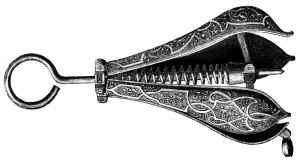
The “pear”. During the witchcraze, torturers heated this tool in a fire, then pushed it into a woman’s vagina, screwing its parts open.
Medicine women continued to practice widely in Europe up until the so-called “Enlightenment” period. Between the Roman Empire and that time, the witchcraze and its “myth of feminine evil” resulted in the slaughter of 9 million people, nearly all women, over 300 years. History remembers this 300-year effort, if at all, as a sort of freak superstitious episode (think of Arthur Miller’s The Crucible). Yet feminist writers like Mary Daly, Andrea Dworkin and Max Dashu offer a different account.
Dworkin writes how many women deemed witches were medicine women, a truth that still exists in our cultural memory, only in distorted and corrupted form, in the frogs-and-cauldron stereotype. But these were not green-faced, evil women. According to Dworkin, it was as midwives, especially, that learned women really offended the Church.
The witches used drugs like belladonna and aconite, organic amphetamines, and hallucinogenics. They also pioneered the development of analgesics. They performed abortions, provided all medical help for births, were consulted in cases of impotence which they treated with herbs and hypnotism, and were the first practitioners of euthanasia.
Anna Göldi is said to have been the last woman executed as a witch in Europe. She was a maidservant to a physician, who accused her of having placed needles in his children’s bread by supernatural means. After attempting to escape trial, she was captured and beheaded in Switzerland in 1782.
In her book Gyn/Ecology, Mary Daly points out how gynecology was established as a practice governed by men after the time of the witch burnings. 1873 marked the publication of Dr. Robert Battey’s invention of ‘female castration’: the removal of women’s ovaries to “cure insanity”. Male gynecologists have since routinely pathologised, and medically and surgically tortured and injured women and women’s bodies through violent childbirth practices, radical mastectomies and hysterectomies, electro- and hormone “therapy”, and lobotomies.
By the 1890s, there was a mad interest in wood and glass prosthetic or mechanical “wombs” (“artificial mothers” or “child hatcheries”) – technology that attempted to challenge the indispensability of women’s bodies. In these incubators we see how the present push by transactivists to neuter and dehumanise the language of pregnancy and childbirth, and sever the connection to women’s bodies and women’s health, has echoes through history.
Daly points out that the male takeover of women’s health after the witchcraze was not coincidental:
Many feminists have noted the significance of the fact that the massacre of the wise women / healers during the witchcraze was followed by the rise of man-midwives who eventually became dignified by the name “gynecologist. Gynecology was slow to rise. Man-midwives of the sixteenth, seventeenth, eighteenth and nineteenth centuries were under fire from woman midwives, such as Elizabeth Nihell, who described their instruments as “weapons of death”. Nevertheless, the nineteenth century saw the erection of gynecology over women’s dead bodies.
The compounding of abuses
J. Marion Sims, “the Father of Modern Gynecology,” used African-American women in slavery to conduct his surgical experiments. Sims medically experimented on black women for research into illnesses like cancer – without providing anesthetics or other pain-numbing medicines. If a woman died from complications or excessive bleeding, Sims simply replaced her with another slave, and his practice was completely legal.

The compounding of oppressions on black women is the topic of Angela Davis’ Women, Race and Class. In it, Davis discusses the experience of black women during the slave trade; including Harriet Tubman (pictured), who rescued over three hundred people through the Underground Railroad and was the only woman in the U.S. ever to lead troops into battle.
Black women, says Davis, had to work as steadily on plantations as men, performing the same tasks, despite the myths that patriarchy perpetuates about women.
Women were not too “feminine” to work in coal mines, in iron foundries or to be lumberjacks and ditch diggers. When the Santee Canal was constructed in North Carolina, slave women were a full fifty percent of the labour force.
Women were sex slaves in addition to this labour. “If the most violent punishments of men consisted in floggings and mutilations,” Davis writes, “women were flogged and mutilated, as well as raped”. White men also saw Black women as “breeders”:
During the decades preceding the Civil War, Black women came to be increasingly appraised for their fertility (or for the lack of it): she who was potentially the mother of ten, twelve, fourteen or more became a coveted treasure indeed. This did not mean, however, that as mothers, Black women enjoyed a more respected status than they enjoyed as workers. Ideological exaltation of motherhood – as popular as it was in the nineteenth century – did not extend to slaves. In fact, in the eyes of the slaveholders, slave women were not mothers at all; they were simply instruments guaranteeing the growth of the labour force. They were “breeders” – animals, whose monetary value could be precisely calculated in terms of their ability to multiply their numbers.
Since slave women were classified as “breeders” as opposed to “mothers”, their infant children could be sold away from them like calves to cows.
 This is another reason we should look sideways at the introduction of terms like “menstruators” and “incubators” into the language of women’s health, pregnancy and childbirth as a result of transactivism today. These phrases have a history, and are tied especially to the dehumanising treatment of black women in sexual slavery. The documentary Google Baby shows how women are currently forced to tolerate life treated as “incubators” in surrogacy clinics in India, often giving birth to white babies in through the use of both egg and sperm donors.
This is another reason we should look sideways at the introduction of terms like “menstruators” and “incubators” into the language of women’s health, pregnancy and childbirth as a result of transactivism today. These phrases have a history, and are tied especially to the dehumanising treatment of black women in sexual slavery. The documentary Google Baby shows how women are currently forced to tolerate life treated as “incubators” in surrogacy clinics in India, often giving birth to white babies in through the use of both egg and sperm donors.
The production-line treatment of women who give birth to babies in surrogacy clinics is spine chilling, yet the surrogacy trade sees 12,000 foreigners per year coming to India to hire the wombs, usually of poor women, in an industry worth an annual $1 billion.
An expression of racist, patriarchal colonisation as painful and brutal as the surrogacy clinics in India would be hard to find, if it wasn’t for the oldest oppression: prostitution. Today, 80% of people used in prostitution are women, as are 98% of sex trafficking victims. Almost all johns are men, and sex trafficking generates men U.S.$32 billion a year. An increasingly violent porn industry accrues about US$97.06 billion, which is more than the combined revenue of the top 10 web technology companies combined. The latest ‘trend’ in porn is for women to be raped anally until they suffer rectal prolapse (“rosebudding“). Nevertheless, Amnesty International has signalled its support for this industry, buckling under pressure from influential pimps.
As Cherry Smiley points out, indigenous women are disproportionately affected. In New Zealand, 15% of women are Māori. In our country’s fully decriminalised sex trade, 32% of prostituted persons are Māori. There is a narrative gaining traction in New Zealand, no doubt fuelled by the white man running programmes at the New Zealand Prostitutes Collective (NZPC), that it is “racist” to critique prostitution because of the Māori and Pacific women within the industry. Remember that demand for this industry comes from wealthy, white men. In 2017, liberals are still being coached to believe that indigenous women are somehow innately predisposed to being subjected to the abuses of wealthy white men.
Angela Davis’ book points out not only how black women have been affected by the compounding of race, class and sex-based oppression, but have also had to fight the hardest for political representation, even in resistance movements. Her book explores the intersection of the abolition movement to end slavery, and the first wave of feminism; neither of which sufficiently represented the plight of black women. Sojourner Truth stood up to the white feminists of the first wave, just as bell hooks to those of the second wave. Today, we again see a white, middle class liberal movement, marketing ‘sex positive’ identity-based liberalism as women’s rights. This has happened because the backlash to each feminist wave has ensured that mainstream feminism has come out the other side domesticated, whitewashed and sexualised.
Sexology, pornography and feminism
In her essay Sexology and Antifeminism, Sheila Jeffreys describes how the “discipline” of sexology was founded as a backlash to the first wave of feminist suffragists.
This period, immediately after World War I, was a time in which many women had considerably more freedom and independence than they had had before. The fact that large numbers of women were not marrying, were choosing to be independent, and were fighting male violence caused considerable alarm. This alarm is apparent in sexological literature.
Many women had little interest in sexual intercourse, and moreover, thought that “no woman should have to do sexual intercourse” (this was, of course, many decades before second wave feminists fought to have marital rape criminalised). In response to this increased resistance and independence, and to defend the status quo of women’s oppression, women’s sexual subordination being naturalised in sexology. Havelock Ellis, the founder of sexology, argued that male sexuality was absolutely and inevitably aggressive, taking the form of pursuit and capture, and that it was normal and inevitable for men to take pleasure in inflicting pain on women. Women’s sexuality, he said, was passive. Women were supposed to be captured and took “delight” in experiencing pain at the hands of male lovers.
Sexologists also invented the concept of women’s “frigidity”: “frigid” women were defective, and had to be sent to gynecologists and psychoanalysts.
Hot off the heels of sexology came the pornography industry that we know today. By the conclusion of World War II, there was big business in the promotion of this objectification of women. Businessmen-pornographers like Hugh Hefner (Playboy) Bob Guccione (Penthouse) and Larry Flynt (Hustler) began grooming the market to make porn socially acceptable. By the 90s, bunny merchandise was being consumed by girls everywhere – the bunny branding everything from stationery to pyjama pants. Cosmopolitan’s publishers, Bauer Media, have been involved in this global sex trade lobbying, and once owned the publishing license for Germany’s Playboy.
“It was a very different world,” says feminist writer Gail Dines, “after Hefner eroded the cultural, economic, and legal barriers to mass production and distribution of porn.”
It is now even considered up for debate now whether pole dancing is the best after school activity for 8-year-olds.
How did this shift to the mainstream happen? The answer is simple: by design. What we see today is the result of years of careful strategising and marketing by the porn industry to sanitise its products… reconstructing porn as fun, edgy, chic, sexy, and hot. The more sanitised the industry became, the more it seeped into the pop culture and into our collective consciousness.
Second wave feminism recognised and resisted the abuse and normalisation of pornography – but the university Women’s Studies departments in which a lot of this critique could be made are no more to be found. Even the books are now under threat. The discipline that usurped Women’s Studies is queer theory, and according to feminists, queer theory is to the second wave of feminism what sexology was to the first: a backlash. Sheila Jeffreys states how this backlash has come from sexual liberals on the left – in particular, from men – and from a large part of the gay male movement. That is where the backlash is coming from, but it is being represented within feminism as well. [My comment: most people forget that feminism/anti-sexism was the umbrella that incorporated and supported homosexual rights and what is now LGBT but for a long time it was all about gay men, lesbian woman were also called ‘gay’.]
Lierre Keith illustrates the representation of this backlash within feminism:
As early as 1982, Ellen Willis invented the term “sex positive” to distinguish herself from radical feminists – because we’re so negative, us radicals. Rape, rape, rape – it’s all we want to talk about. Well, I’ll make you a deal – if men stop with the rape, I’ll stop talking about it.
Keith also points out that the search term “torture porn” results in 32 million online hits. It is worth noting that the aesthetic, the tools and the practices of modern pornography and BDSM endorsed in “edgy” and “sex positive” queer theory and ‘kink’ stem back to the witch trials. Max Dashu’s essay Reign of the Demonologists shows how the torture of witches was sexualised, through fetishised torture routines and equipment and forced confessions of grotesque sex with devils. An interview with Audre Lorde in Burst of Light critiques sadomasochism for similar reasons.
Sadomasochism is congruent with other developments going on in this country that have to do with dominance and submission, with disparate power – politically, culturally and economically… Sadomasochism is an institutionalised celebration of dominant/ subordinate relationships… Sadomasochism feeds the belief that domination is inevitable and legitimately enjoyable.
Feminist Susanne Kappeler offers us a reminder for when we find these kinds of practices accepted and celebrated as groundbreaking in academia.
As feminists, we would do well do remember and highlight the fact that the history of liberalism, of libertarianism, and libertinism has been a history of gentlemen advocating liberty and license for gentlemen – liberties to which the rights and liberty of women have routinely been sacrificed.

Copy of a 1515 “witch porn” drawing by Hans Franck.
Commodification and “choice”
The production of sex robots is a contemporary, further entrenchment of the objectification of women that disciplines like queer theory allow to slip by, and even celebrate. Eating disorders and demand for cosmetic surgeries like labiaplasty are only two examples of the impact of escalating objectification on women. We are seeing other bizarre inventions on the market, too: the penis FitBit, a mouthpiece for blowjobs.
One way that the sex trade lobby gets under women’s skin, sucks confidence, encourages competition and fosters dependency like an abusive partner or a pimp, is through media, through women’s magazines. 70% of women report experiencing guilt and shame after three minutes of browsing these kinds of magazines. It is well known that publishers and their advertisers feed off insecurity – and abuse. Most models in these magazines weigh 25% less than the average woman, and are in the anorexia weight range. Now, in the U.S. and EU, 50 million women suffer from eating disorders, and girls as young as six are increasingly expressing anxiety about their shape.
Bauer Media publishes Cosmopolitan, Woman’s Day and teen magazine Dolly. It also currently profits from online porn, and used to hold publishing licenses for a range of German porn magazines: the German Playboy; Das neue Wochenend; Blitz Illu; Schlüsselloch (which means ‘keyhole’); Sexy, Praline and Coupé. Bauer Media also own one third of the famous private T.V. channel RTL II, which airs pro “sex work” reality shows almost daily. It’s not surprising to see the latest issue of Cosmopolitan offer advice on invasive cosmetic treatments from brow tattoos, to lip filling, laser treatment and light therapy.
Labiaplasty – surgical reduction of women’s labia – is another Western trend on the rise that has connections to more brutal practices, in this case that of female genital mutilation (FGM). According to the WHO (who actually endorsed this practice in 1958) more than 200 million girls and women alive today have been cut in 30 countries in Africa, the Middle East and Asia where FGM is concentrated. These practices can see girls having their clitoris or labia removed; in Somalia, there is a practice of sewing up the labia, leaving only a small hole. Somali woman Hibo Wardere says urinating through such an opening feels like “an open wound rubbed with salt or hot chilli.” Feminism needs to work to end genital mutilation, not get busy glorifying new, commercial varieties as sex-positive “choice”.
Patriarchy mines and cuts up women’s bodies whilst women’s worth is undermined. From the tenth century and for ten centuries of course, Chinese patriarchs saw to it that girls and women would never run around, by binding their feet, and fetishising this act of crippling women. Today we see trades in woman’s hair, our eggs, breast milk and wombs rented through surrogacy. While surrogates are normally poor women; egg donors are usually young, educated women screened for heredity diseases and not warned of the implications or possible side effects of egg harvesting.
Mainstream, white feminism will today frame labiaplasty as something women ‘choose‘. Like immolation was ‘chosen’ throughout the practice of the Indian suttee. Like mothers ‘chose’ to bind their daughters’ feet, ‘choose’ to cut out their clitorises; like women ‘choose’ to be prostituted and even trafficked, to wear the burqa, to wear stilettos, to not eat, to bind their breasts flat. Not only are these practices so often marketed and claimed as ‘choice’, but altruism. [My comment: a lot of women enable these practices to continue by a) endorsing them (like middle and upper class White women who claim university campus rape is a part of culture and girls shouldn’t moan about it) and/or b) not standing up against it, many think they went through it therefore the next generation has to and there’s plenty of cases where women are behind it. If they had stood up a long time ago things might have been different… But that’s wishful thinking. However there are also women who believe that mutilation is a form of protection against non-acceptable males (‘acceptable’ being the ones generally forced on them via marriage or ‘favour’/obligation and that includes one’s boss if you work). It’s all brainwashing.] Prostitution, surrogacy, and immolation have all been called ‘atruistic’ practices. Women, obviously, want to be able to choose and to contribute. And what choices does society allow us to make? These. So we claim to have made these choices ourselves. But feminism needs to acknowledge what Meagan Tyler does – that yes, “we make choices, but these are shaped and constrained by the unequal conditions in which we live.”

NZPC markets prostitution as a woman’s “choice”.
When it comes to modern trends like transgenderism, we cannot separate the male desire for access to women’s spaces and for uterus transplants, from a history of patriarchal appropriation (including “prosthetic womb” imitations). We cannot separate this movement from the entire history that precedes it, of the simultaneous mining of women’s bodies and undermining of women’s worth. We also cannot separate men’s desires to stifle and appropriate the discussion and capacity of women’s ability to create life from a history of the same. The white, male establishment has worked to appropriate control of women’s bodies and ability to create human life, and to stifle feminist dissent, since it came to power. In this Trump era, that history continues.
Conversely, we cannot separate women’s manufactured desires for male privilege, and women’s “choices” to undergo breast ironing and binding, mastectomies and invasive surgery from a history of oppression, demonisation, mutilation and self harm.
We cannot separate any discourse on gender from the realities of sex-based oppression – that’s if we ever want freedom.

————————————————————————————————————————————————–
The 25 Most Unimaginable Medieval Torture Devices!
March 30, 2015 at 14:10PM
https://moviepilot.com/posts/2820059
ByAnna Olvera, writer at Creators.co Writer, Filmmaker and Horror Geek at MoviePilot. Like and Follow me at Screaming for Horror on Facebook and @Raging_Rain on Twitter.
During the Medieval Ages mainly nobles and royalty had pretty much power over society. Although when it came to “justice” it wasn’t any different. Most people with low resources such as peasants, labor workers and farmers, had little to no rights, when it came down to the “law”. The dark age torturers and executioners that created these devices, were really imaginative when it came down to torturing others and apparently it payed off because millions of people suffered the unimaginable when it came to their deaths. Most of them highly painful and very slow, while others were used as means of interrogation. Unfortunately many people died when these devices were used, but the ones that didn’t still suffered a great amount of pain and were scarred for life. Next I’ve put together a list of the 25 worst medieval torture devices.
NOTE: NOT ALL torture devices are listed here.
1.- SAW TORTURE
In this method, the victim is hung upside down, so that the blood will rush to their heads and keep them conscious during the long torture. The torturer would then saw through the victims’ bodies until they were completely sawed in half. Most were cut up only in their abdomen to prolong their agony.
2.- THE CHAIR OF TORTURE
Also known as the Judas Chair, it was a terrible, intimidating torture device that was added to dungeons in the Middle Ages. Used until the 1800′s in Europe, this chair was layered with 500 to 1,500 spikes on every surface with tight straps to restrain its victim. Made of iron, it can also contain spaces for heating elements beneath the seat. It was often used to scare people into giving confessions as they watched others being tortured on the device.
3.- THE RACK
Is a torture device consisting of a rectangular, usually wooden frame, slightly raised from the ground, with a roller at one or both ends. The victim’s ankles are fastened to one roller and the wrists are chained to the other. As the interrogation progresses, a handle and ratchet mechanism attached to the top roller are used to very gradually increase the tension on the chains, inducing excruciating pain. By means of pulleys and levers this roller could be rotated on its own axis, thus straining the ropes until the sufferer’s joints were dislocated and eventually separated. Additionally, if muscle are stretched excessively, they lose their ability to contract, rendering them ineffective. One gruesome aspect of being stretched too far on the rack is the loud popping noises made by snapping cartilage, ligaments or bones.
4.- BREAST RIPPER
Known in another form as the Iron Spider or simply the spider, was a torture instrument mainly used on women who were accused of adultery, or self-abortion. The instrument was designed to rip the breasts from a woman and was made from iron, which was usually heated. The tool was used popularly in the Free State of Bavaria, a state in Germany, in 1599, and in parts of Germany and France until the nineteenth century.
5.- TONGUE TEARER
Looking like an over sized pair of scissors, it could effortlessly cut the victim’s tongue. Their mouth would be forced opened with a device called a mouth opener, and then the iron tongue tearer would uncomfortably twitch the tongue with its rough grippers. Once a firm hold was maintained, the screw would be firmly tightened and the victim’s tongue would roughly be torn out.
6.- IRON MAIDEN
This torture device consisted of an iron cabinet with a hinged front and spike-covered interior, sufficient enough to enclose a human being. Once inside its conical frame, the victim would be unable to move due to the great number of steel spikes impaling them from every direction. The interrogator would scream questions at the victim while poking them with jagged edges.
7.- GUILLOTINE
One of the most notorious forms of executions, the guillotine was made of a razor sharp blade attached to a rope. The victim’s head was placed in the middle of the frame as the blade dropped, severing the victim’s head from the body. Since the decapitation was considered to be an instant and painless event (at least less painful than the other torture methods), it was often considered the most humane method of execution.
8.- THE BRAZEN BULL
Also known as the Sicilian Bull, it was designed in ancient Greece. A solid piece of brass was cast with a door on the side that could be opened and latched. The victim would be placed inside the bull and a fire set underneath it until the metal became literally yellow as it was heated. The victim would then be slowly roasted to death all while screaming in agonizing pain. The bull was purposely designed to amplify these screams and make them sound like the bellowing of a bull.
9.- BOOT
The term boot refers to a family of instruments of torture and interrogation variously designed to cause crushing injuries to the foot and/or leg. The boot has taken many forms in various places and times. Common varieties include the Spanish boot and the Malay boot. One type was made of four pieces of narrow wooden board nailed together. The boards were measured to fit the victim’s leg. Once the leg was enclosed, wedges would be hammered between the boards, creating pressure. The pressure would be increased until the victim confessed or lost consciousness. Newer variants have included iron vises,sometimes armed with spikes that squeezed feet and metal frames employed red hot.
10.- HANGED, DRAWN AND QUARTERED
During medieval times, the penalty for high treason in England was to be hanged, drawn and quartered in public and though it was abolished in 1814, it has been responsible for the death of thousands of people. In this torture technique, the victim is dragged in a wooden frame called a hurdle to the place of execution. They would then be hanged by the neck for a short period of time until they are near-death (hanged), followed by disembowelment and castration where the entrails and genitalia are burned in front of the victim (drawn). The victim would then be divided into four separate parts and beheaded (quartered).
11.- STRAPPADO
The Strappado is a form of torture in which the victim’s hands are first tied behind his or her back and suspended in the air by means of a rope attached to wrists, which most likely dislocates both arms. Weights may be added to the body to intensify the effect and increase the pain. Other names for strappado include “reverse hanging” and “Palestinian hanging” (although it is not used by the Palestinian Authority) It is best known for its use in the torture chambers of the medieval Inquisition.
12.- WOODEN HORSE/SPANISH DONKEY
One of the torture devices during the Spanish Inquisition and medieval ages, this is probably one of the most gruesome of them all. The victim is put astride, naked, on a donkey-like apparatus, which is actually a vertical wooden board with a sharp V-wedge on top of it. After that, the torturer would add varying weights to the victim’s feet until finally the wedge sliced through the victim’s body.
13.- PEAR OF ANGUISH/CHOKE PEAR
The pear of anguish or choke pear is the modern name for a type of instrument displayed in some museums, consisting of a metal body (usually pear-shaped) divided into spoon-like segments that could be spread apart by turning a screw. The museum descriptions and some recent sources assert that the devices were used either as a gag, to prevent people from speaking, or internally as an instrument of torture.
14.- JUDAS CRADLE
The victim would presumably be placed in the waist harness above the pyramid-shaped seat, with the point inserted into their an*s or v*gin*, then very slowly lowered by ropes. The subject is tortured by intense pressure and stretching of the orifice, eventually succumbing to tears in muscle tissue that could turn septic and kill from infection, or simply being impaled.
15.- CRUCIFIXION
Principally practiced in antiquity, though it remains practiced in some countries today; it is one of the most well-known execution methods due to the crucifixion of Jesus Christ. It is a deliberately slow and painful execution where the condemned person is tied or nailed to a large wooden cross and left to hang until they die, which usually takes days.
16.- NECK TORTURE
Humiliating and painful, this punishment was something of an endurance test where the victim would be hooked into a neck device, either made of metal or wood, which prevented the victim from adjusting into a comfortable position. The cruelty of this punishment lie within the fact that they were unable to lie down, eat, or lower their head for days.
17.- HERETIC’S FORK
The device was placed between the breast bone and throat just under the chin and secured with a leather strap around the neck, while the victim was hung from the ceiling or otherwise suspended in a way so that they could not lie down.Usually the Heretic’s fork was given to people who spoke the lord’s name in vain, blasphemers, or liars. This way, the punishment made it nearly impossible for them to talk. Also, a person wearing it couldn’t fall asleep. The moment their head dropped with fatigue, the prongs pierced their throat or chest, causing great pain. This very simple instrument created long periods of sleep deprivation. People were awake for days, which made confessions more likely.
18.- BREAKING WHEEL/ CATHERINE WHEEL
Was a torture device used for capital punishment from Antiquity into early modern times for public execution by breaking the criminal’s bones/bludgeoning him to death. As a form of execution, it was used from “Classical” times into the 18th century; as a form of post mortem punishment of the criminal, the wheel was still in use into 19th century Germany.
19.- SHREW’S FIDDLE/ NECK VIOLIN
is a form of rigid irons whereby the wrists are locked in front of the bound person by a hinged board or steel bar. It was originally used in the 18th century as a way of punishing women who were caught bickering or fighting.
20.- COFFIN TORTURE
The most preferred torture technique in the Middle Ages was known as coffin torture. This method involved placing the victim inside a metal cage roughly the size of the human body; hence the name. The torturers also forced overweight victims into smaller cages to heighten their discomfort as they hung from a tree or gallows. Generally, they would be left there until the crows came to feed on their remains.
21.- SPANISH TICKLER/ CAT’S PAW
Is a type of torture instrument, consisting of long, sharp iron spikes curved so as to resemble claws. It was often attached to a handle, or else used as an extension of the torturer’s hand. In this way it was used to rip and tear flesh away from the bone, from any part of the body. It was also used as a weapon. This device was commonly used on thieves and unfaithful wives. Most who were tortured in this manner died not at the time, but afterwards. Especially with the Cat’s Paw, the device would cause infections as the device would cut so deep. The prongs were nearly never washed, so the chances of these infections were very high.
22.- KNEE SPLITTER
The knee splitter was a form of torture used mainly during the inquisition. It was created from two spiked wood blocks, placed in front of, and behind the knee. The blocks were connected with two large screws. When turned, the blocks would close towards each other, destroying the knee underneath them. This method was used to render the knees useless. The number of spikes on the blocks would range from three to twenty, depending on the captive.
23.- HEAD CRUSHER
This metal device featured a plate that sat below the victim’s jaw, which was connected by a frame to the head cap. As the torturer slowly twisted the handle, the gap between the head cap and plate decreased in width, causing crushing of the skull and facial bones, including teeth and jaws, and ultimately inducing death; even if the torturer stopped before death, permanent damage to the facial muscles and structure would occur. The victim’s head would slowly be crushed, killing the victim, but not before the victim’s jaw had been crushed, and their eyes had popped from their socket.
24.- THUMBSCREW/ PILLYWINKS
Is a torture instrument which was first used in medieval Europe. It is a simple vice, sometimes with protruding studs on the interior surfaces. The victim’s thumbs or fingers were placed in the vice and slowly crushed. The thumbscrew was also applied to crush prisoners’ big toes. The crushing bars were sometimes lined with sharp metal points to puncture the thumbs and inflict greater pain in the nail beds. Larger, heavier devices based on the same design principle were applied to crush feet and ears.
25.- IMPALEMENT
Given his name, it should come as no surprise that this was the most favored method of execution by Vlad the Impaler. In 15th century Romania; the victim was forced to sit on a sharp and thick pole. When the pole was then raised upright, the victim was left to slide down the pole with their own weight. It could take the victim 3 days to die using this method and it has been said that Vlad once did this to 20,000 people all while enjoying a meal.
———————————————————————————————————————————————
The above posts show that there is something seriously wrong with humanity; we’re deeply cruel, traumatized and haunted to the point of normalized atrocity and apathy.


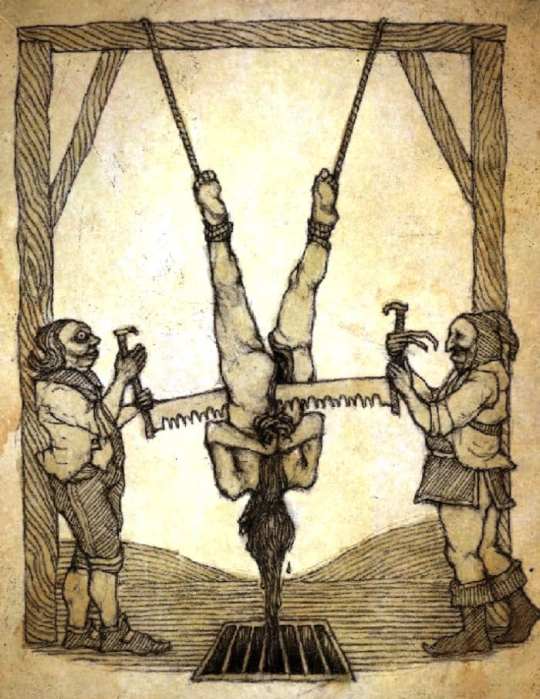
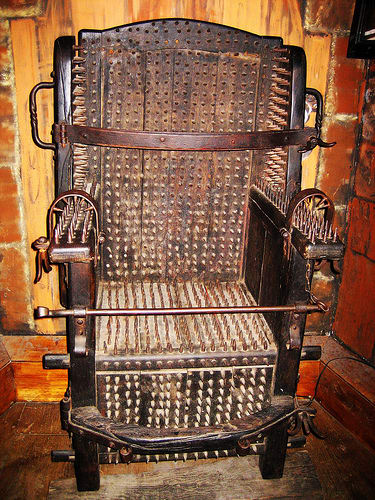
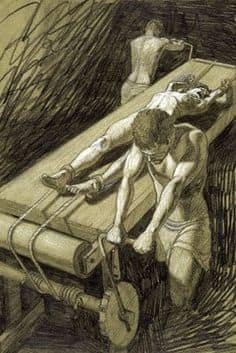

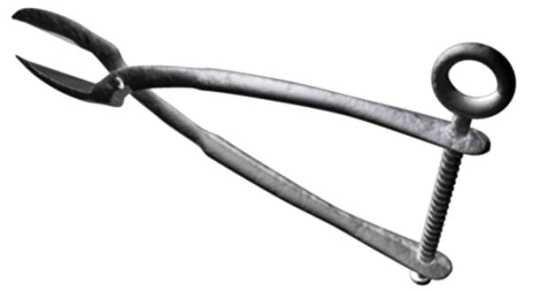

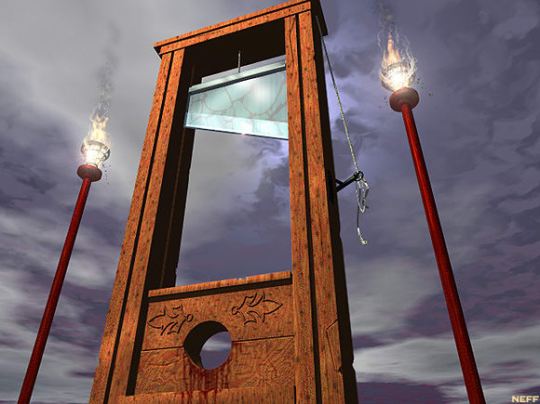
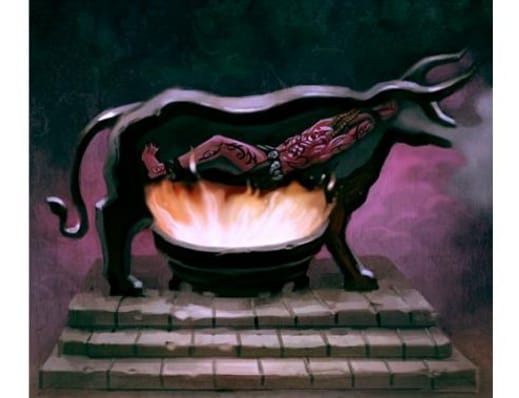
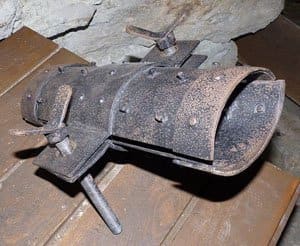
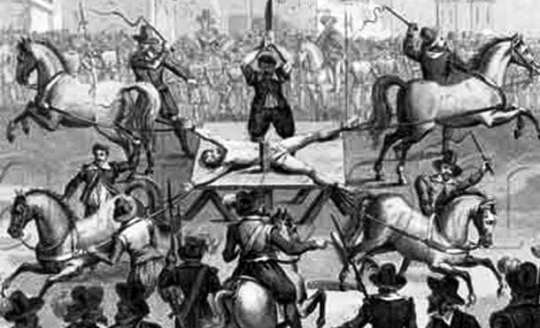

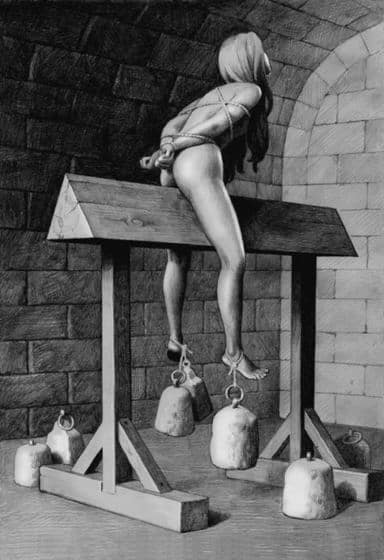
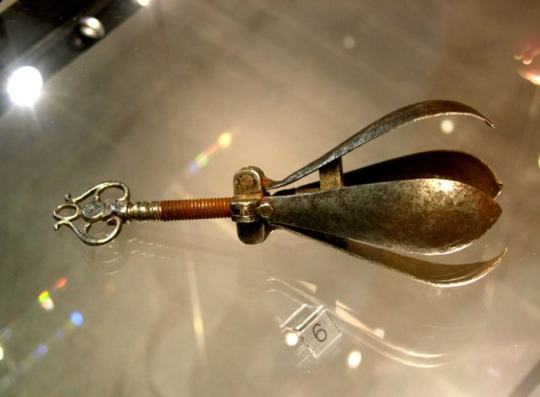
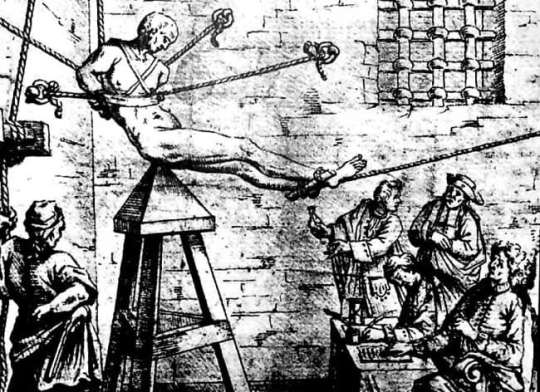
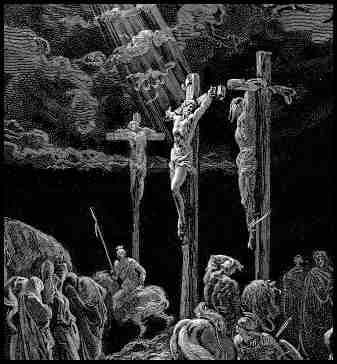
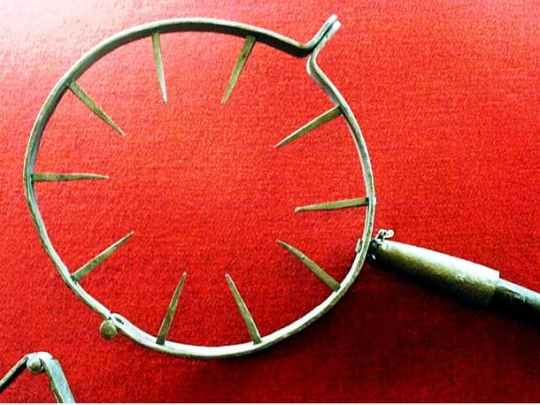
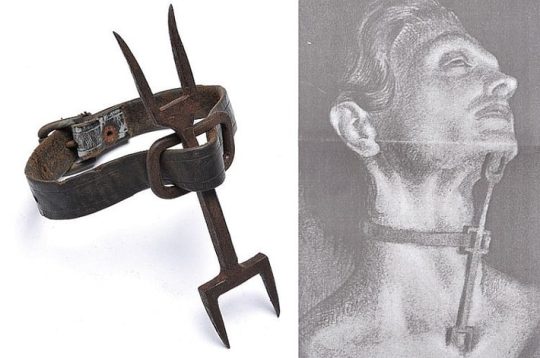

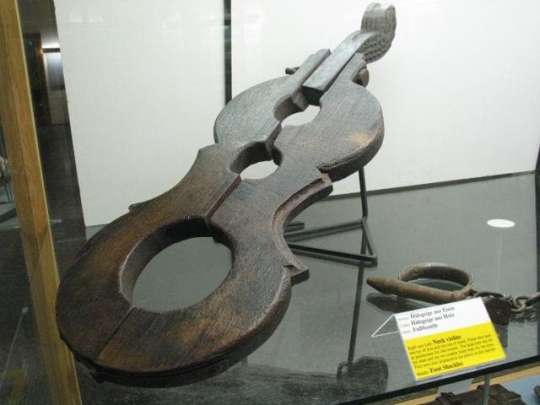
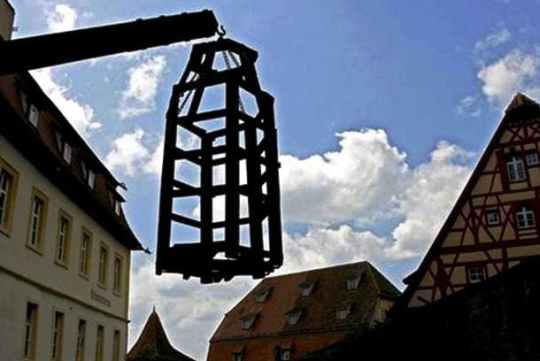

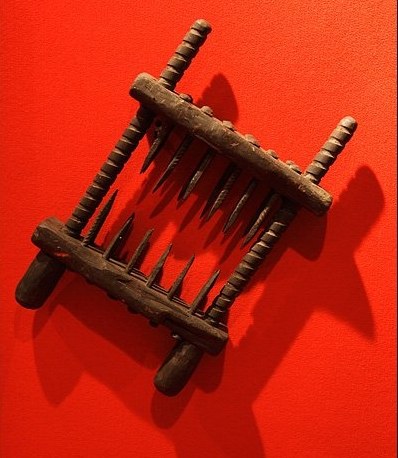
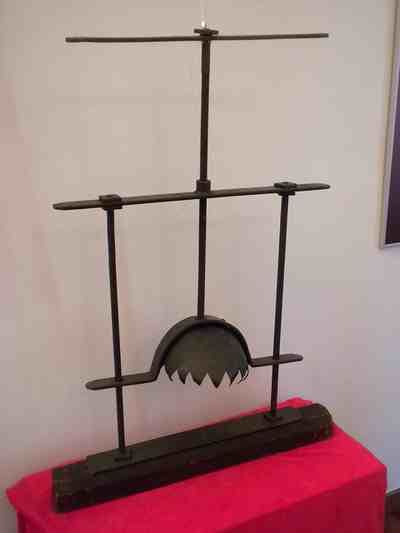
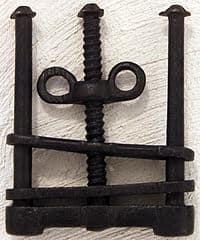




Written
on February 10, 2017